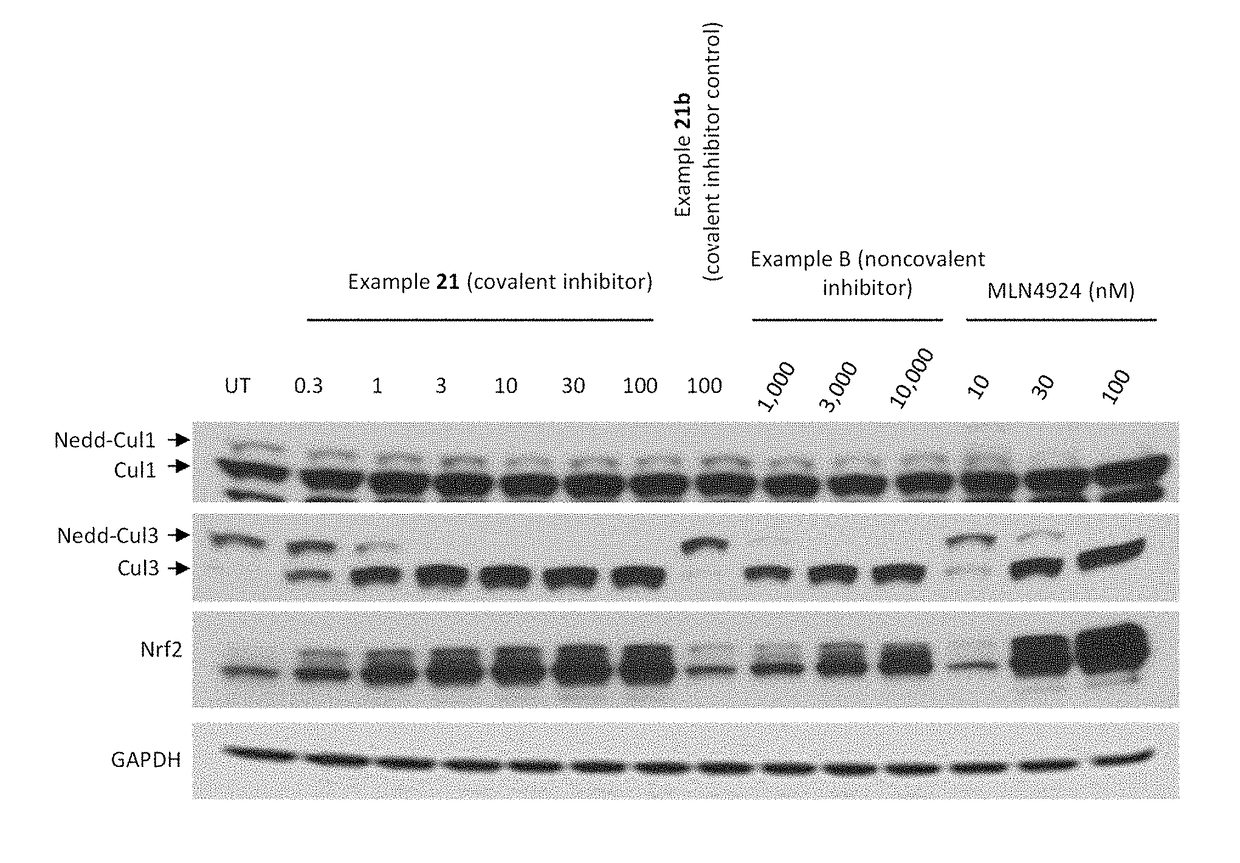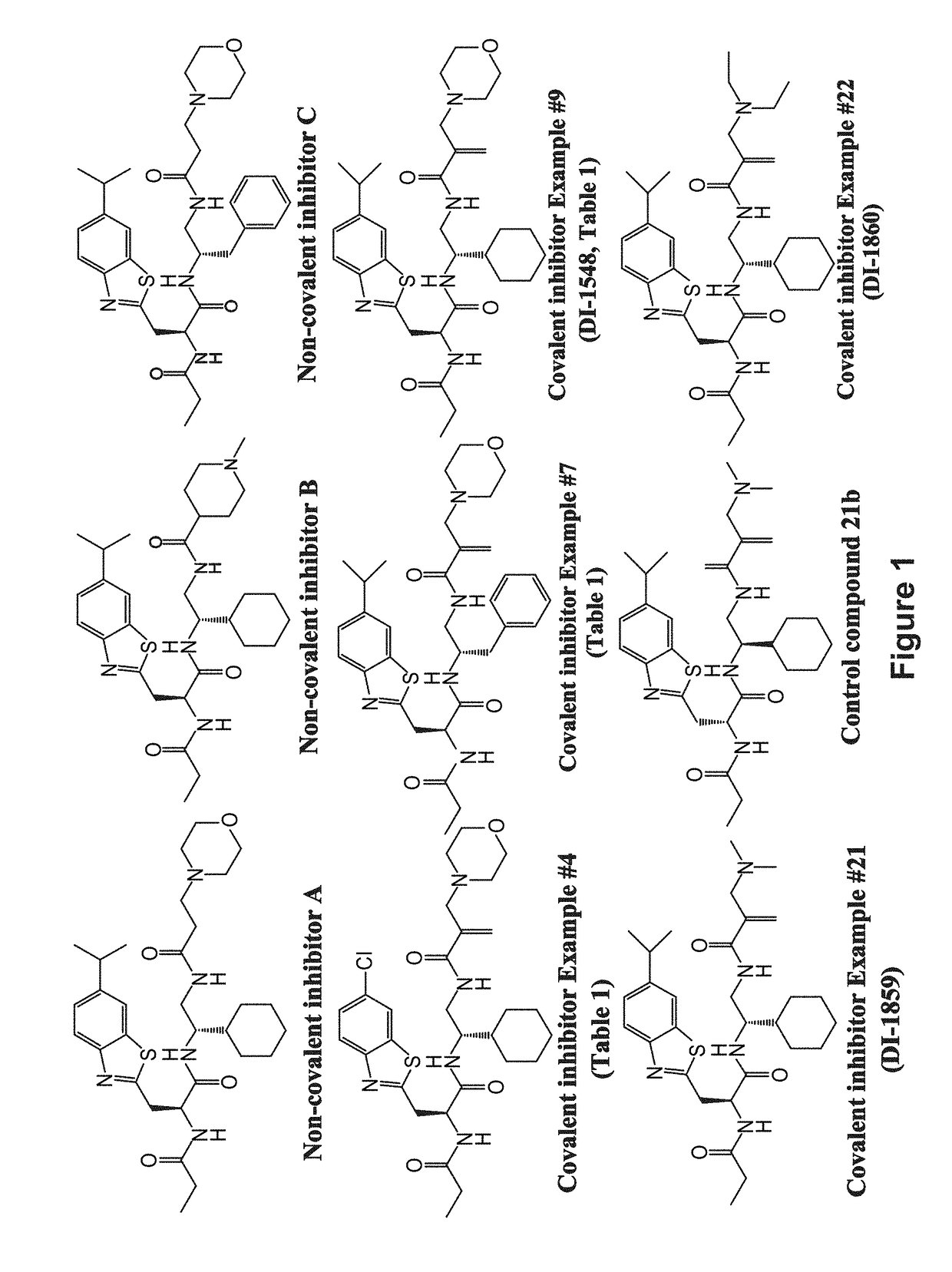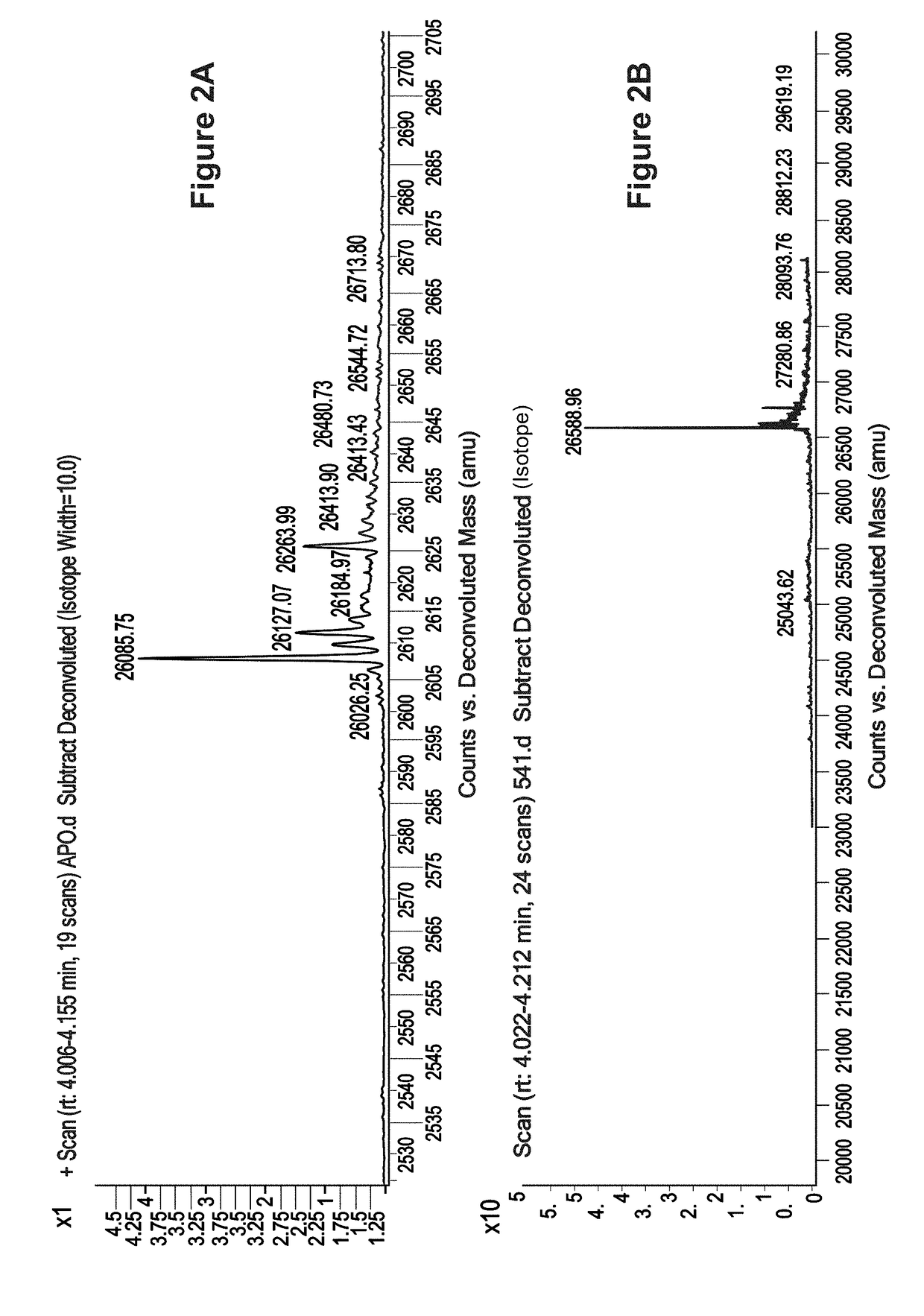Covalent Small Molecule DCN1 Inhibitors and Therapeutic Methods Using the Same
- Summary
- Abstract
- Description
- Claims
- Application Information
AI Technical Summary
Benefits of technology
Problems solved by technology
Method used
Image
Examples
example 1
[0429]N—((S)-2-((S)-3-(6-chlorobenzo[d]thiazol-2-yl)-2-propionamidopropanamido)-3-phenylpropyl)acrylamide: Compound 6bBnPr (40 mg, 0.09 mmol, 1 equiv.) was added to a solution of acrylic acid (8 mg, 0.11 mmol, 1.2 equiv.), HBTU (51 mg, 0.13 mmol, 1.5 equiv.) and DIEA (47 μL, 0.27 mmol, 3 equiv.) in DCM (5 mL). The resultant mixture was stirred at room temperature for 1 h and concentrated. The residue was purified by HPLC to afford Example 1 (37 mg, 81%). 1H NMR (400 MHz, MeOD:CCl3D=1:1) δ 7.88 (d, J=1.8 Hz, 1H), 7.82 (d, J=8.7 Hz, 1H), 7.44 (dd, J=8.7, 2.1 Hz, 1H), 7.29-7.11 (m, 5H), 6.21-6.08 (m, 2H), 5.59 (dd, J=9.7, 2.2 Hz, 1H), 4.80 (dd, J=7.5, 5.6 Hz, 1H), 4.22-4.15 (m, 1H), 3.53 (dd, J=15.2, 5.6 Hz, 1H), 3.44-3.34 (m, 3H), 2.80 (d, J=7.1 Hz, 2H), 2.22 (q, J=7.6 Hz, 2H), 1.07 (t, J=7.6 Hz, 3H).
example 2
[0430](E)-N—((S)-2-((S)-3-(6-chlorobenzo[d]thiazol-2-yl)-2-propionamidopropanamido)-3-phenylpropyl)-4-(dimethylamino)but-2-enamide. Example 2 was prepared from Compound 6bBnPr by a similar procedure as that described for Example 1. 1H NMR (400 MHz, MeOD) δ 8.01 (d, J=2.0 Hz, 1H), 7.89 (d, J=8.7 Hz, 1H), 7.50 (dd, J=8.7, 2.1 Hz, 1H), 7.35-7.11 (m, 5H), 6.69 (dt, J=14.9, 7.3 Hz, 1H), 6.33 (d, J=15.3 Hz, 1H), 4.82 (dd, J=8.8, 5.1 Hz, 1H), 4.37-4.17 (m, 1H), 3.90 (d, J=6.9 Hz, 2H), 3.53 (dd, J=15.3, 5.1 Hz, 1H), 3.47 (dd, J=13.7, 4.6 Hz, 1H), 3.40-3.34 (m, 2H), 2.90 (s, 6H), 2.88-2.74 (m, 2H), 2.25 (q, J=7.6 Hz, 2H), 1.06 (t, J=7.6 Hz, 3H).
example 3
[0431]N—((S)-2-((S)-3-(6-chlorobenzo[d]thiazol-2-yl)-2-propionamidopropanamido)-3-phenylpropyl)-2-(morpholinomethyl)acrylamide: Example 3 was prepared from Compound 6bBnPr by a similar procedure as that described for Example 1. 1H NMR (400 MHz, MeOD) δ 8.01 (d, J=1.8 Hz, 1H), 7.88 (d, J=8.7 Hz, 1H), 7.51 (dd, J=8.7, 2.1 Hz, 1H), 7.35-7.08 (m, 5H), 6.18 (s, 1H), 5.96 (s, 1H), 4.81 (dd, J=8.6, 5.3 Hz, 1H), 4.43-4.30 (m, 1H), 4.12-3.73 (m, 6H), 3.62-3.34 (m, 5H), 3.32-3.03 (m, 3H), 2.89-2.78 (m, 2H), 2.29 (tt, J=7.7, 4.0 Hz, 2H), 1.08 (t, J=7.6 Hz, 3H). 13C NMR (101 MHz, MeOD) δ 175.95, 171.33, 171.25, 168.78, 167.42, 151.30, 137.72, 136.48, 132.70, 130.89, 128.94, 128.82, 128.11, 126.70, 126.22, 122.91, 121.19, 63.47, 58.50, 52.95, 51.80, 51.18, 43.00, 37.76, 34.91, 28.63, 8.66.
PUM
| Property | Measurement | Unit |
|---|---|---|
| Molar density | aaaaa | aaaaa |
| Molar density | aaaaa | aaaaa |
| Molar density | aaaaa | aaaaa |
Abstract
Description
Claims
Application Information
 Login to View More
Login to View More - R&D
- Intellectual Property
- Life Sciences
- Materials
- Tech Scout
- Unparalleled Data Quality
- Higher Quality Content
- 60% Fewer Hallucinations
Browse by: Latest US Patents, China's latest patents, Technical Efficacy Thesaurus, Application Domain, Technology Topic, Popular Technical Reports.
© 2025 PatSnap. All rights reserved.Legal|Privacy policy|Modern Slavery Act Transparency Statement|Sitemap|About US| Contact US: help@patsnap.com



